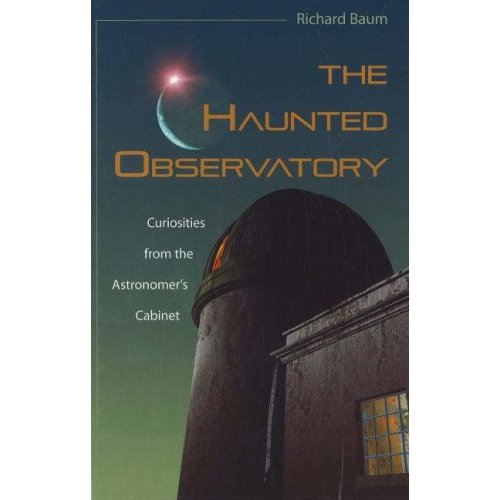[/caption]
Curious and curiouser things began happening when telescopes opened up to the skies. Richard Baum’s book entitled “The Haunted Observatory – Curiosities from the Astronomer’s Cabinet” has the reader thinking like Alice might have in her wonderland. Bright lights, aspiring dots, gleaming trails of a forgotten impression can all fool a mind into perceiving reality where none may exist. Thus, when it comes to making reason out of the unexpected, some astronomer’s lives get so entertaining and worthwhile and ends up making this book so entertaining.
In the seventeenth century, Galileo built his own telescope, viewed moons and rebuilt our perception of the universe. Jumping off from this, telescopes came into ever more common usage so that by the eighteenth and nineteenth centuries, it seemed like everyone and their brother’s uncle had one and was getting excited about what they saw. With the increasing number of observers, some odd things were seen or at least imagined. Perhaps the sights were real events or perhaps they were dust on a lens. In any case, sometimes different people provided different interpretations, thus leading to vibrant discord. Such discord is the resonance of this book as it looks at how some disagreements were solved and how some remain to be solved.
As spiritual hauntings are resolved from much investigation, so to are the oddities in Baum’s book. As if to prove the point, the book has a quarter of its pages dedicated to references and bibliographies. Yet this content is pertinent, as Baum’s writing style interposes many large passages and quotes from external sources and intermixes them with his connecting sentences. With seven of the eleven essays previously published in 1973 and since updated, the result is a smooth flowing discourse. However, Baum likes his verbiage, as seen with phrases like ‘a chaotic vade mecum of the incongruous, the variegated and the exotic’. Given that this isn’t most people’s dictum of the day, the average reader may get bogged down. But, as Baum’s curiosities are mostly set in old European times, his words add to the book’s flavour, thus setting the tone of his investigative reporting.
And, in effect, his book reads like a collection of investigative reports. Within it, Baum usually identifies observers, equipment, date, atmospheric conditions and stellar location for each. For example, ‘he [Schroter] with the seven-foot again fit for use, picked up Venus before sunset and at six o’clock proceeded to examine it with a magnifying power of x95’. Such exact detail allows the reader to work alongside the investigation and resolve for themselves possible factors and events that might have given rise to an unexpected observation. But, the reader will quickly discover that these cases are extremely ‘cold’. That is, either the issue has been resolved (e.g. Venus doesn’t have polar ice caps) or there’s never been a repetition (e.g. strange bright light source beside Venus just as the light set on one day). Thus, the reader will enjoy this book if they like a sense of mystery and intrigue but not if they expect to resolve the investigation on their own.
An historian would also get great pleasure from reading this book. In particular, the book shows the rise of transition of technical ability, as with astronomy, into a mature, understood science. Personalities come to the fore, then they influence observations for all the right and wrong reasons and eventually shuffle quickly off this mortal coyle. Conjecture rises, flourishes and gets dashed, with no thought for social niceties. With this, the book provokes a harsh but real glimpse into scientific investigation and human frailties.
In consequence, though no spiritual ghosts permeate through the pages, Richard Baum’s book “The Haunted Observatory – Curiosities from the Astronomer’s Cabinet” is hauntingly nice. Perhaps the reader will see themselves in the pages as the young, fresh observer or the seasoned, opinionated veteran. In either case, there’s some rewarding reading when opening up this book’s pages.

